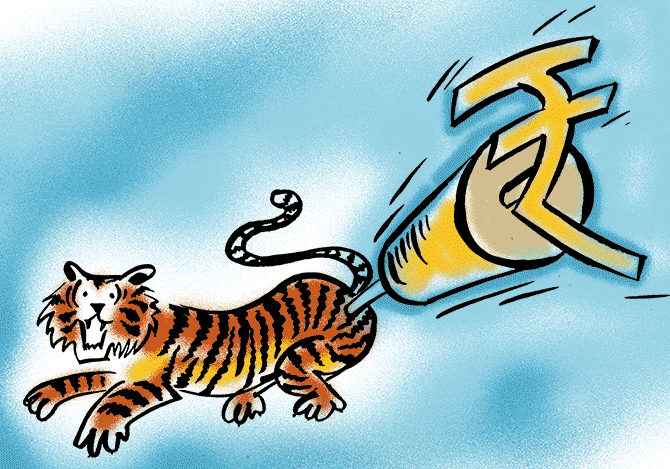'Just look at how India has succeeded in doubling the population of its tigers in the last decade, a period in which the economy has also registered high growth rates.
'Now, every stakeholder, whether the government, judiciary, industry, NGOs and citizens must accept, in principle, that India can grow rapidly while preserving the environment -- forests and fauna, air and water,' says Dhiraj Nayyar.
Illustration: Dominic Xavier/Rediff.com.

It is lazy and wrong to view the goals of economic growth and conservation of the environment as inherently contradictory.
It may even be convenient for some interests.
The reality is different. Just look at how India has succeeded in doubling the population of its tigers in the last decade, a period in which the economy has also registered high growth rates.
In fact, the population of tigers declined drastically over the long decades when economic growth was not so high.
Now, every stakeholder, whether the government, judiciary, industry, NGOs and citizens must accept, in principle, that India can grow rapidly while preserving the environment -- forests and fauna, air and water.
Often, it is unhelpful to put environment before economic growth. Poverty, or the lack of prosperity, leads to much greater environmental degradation.
If the majority is living a subsistence livelihood, if industries are primitive (in a technological sense) and if government is starved of resources -- all the characteristics of under-development -- the consequences for the environment are severe and the possibilities of mitigation or upgradation near zero.
Prosperity is good for the environment.
For a start, it endows the government with greater financial resources to address the challenge of environmental degradation.
It also enables the population to be more educated and aware -- without citizen participation, government efforts to preserve the environment will amount to nothing.
It makes industry more advanced, profitable and able to use the best in class technologies to minimise adverse impact in terms of air and water pollution and dislocation of flora and fauna.
The most significant gain from rapid economic progress is on the technology front. That helps directly in conservation of the environment.
Among other things, tigers have been protected and nurtured through the latest tracking technology. Those who attempt to illegally kill them, that is, poachers, or those who destroy their natural habitats, for instance, illegal logging/deforestation, can be caught and deterred through the deployment of appropriate technology.
In industries like mining, for example, which have traditionally been viewed as damaging to nature, technology has advanced to enable successful transplantation of flora and fauna to alternative locations.
It is not unusual for mining companies to have bio-diversity officers in-house or to partner with international organisations working in the field of the environment to achieve this.
Importantly, once the mining work has been completed and the area vacated by man and machine, the entire ecosystem can return to its original state.
There is evidence of this in India (in Goa) and abroad (in South Africa) where industry is mandated to spend the resources to make sure that the regeneration happens at a very fast pace.
But what of damage already done?
The good news is that nature regenerates itself. Damage can be reversed.
Often, the absence of human beings helps, as the curious case of the Chernobyl disaster zone in Ukraine has proved.
Three decades after a catastrophic nuclear accident rendered a large zone unfit for human habitation -- radiation is still dangerously high -- both flora and fauna have reappeared to reclaim the area.
With planning and management, the regeneration can be achieved without large-scale human displacement necessitated by disaster.
It is already happening.
The positive news on the tiger population is not the only reason to be optimistic in India.
According to the Union minister for environment and forests, India’s forest cover has grown by 16,000 square kilometers in the last five years.
India’s experience in successfully expanding its forest cover is not unique. Europe has achieved impressive rates of reforestation adding an estimated 90,000 square kilometres (approximately the size of Portugal) in the 25 years since 1990.
Perhaps, it is easier for advanced economies for the obvious reason that they are rich and have greater resources and fewer polluting industries -- those have been outsourced to the emerging economies. But the point is that deliberate intervention can aid regeneration.
Needless to say, it is important to not get carried away and give economic growth unfettered priority over nature because the quality of that growth will be poor and it will be unsustainable.
Worse, it will adversely affect the livelihoods and health of all citizens which would negate the hard-won prosperity.
The admittedly tough challenge for the government and courts is to strike the right balance.
Stalling economic activity, by invoking the environment, is likely to be counter-productive unless, of course, there are very pressing reasons to do so.
At the very least, the possibilities of mitigation with the use of technology and ample financial commitment must be heard before a final decision is made.
Industry must become responsible. And civil society must not be irresponsible.
India, which is already charting a unique economic trajectory, has an opportunity to show the world that it is possible to become richer and greener at the same time.
A 21st century tiger economy.
Dhiraj Nayyar is Chief Economist, Vedanta.











